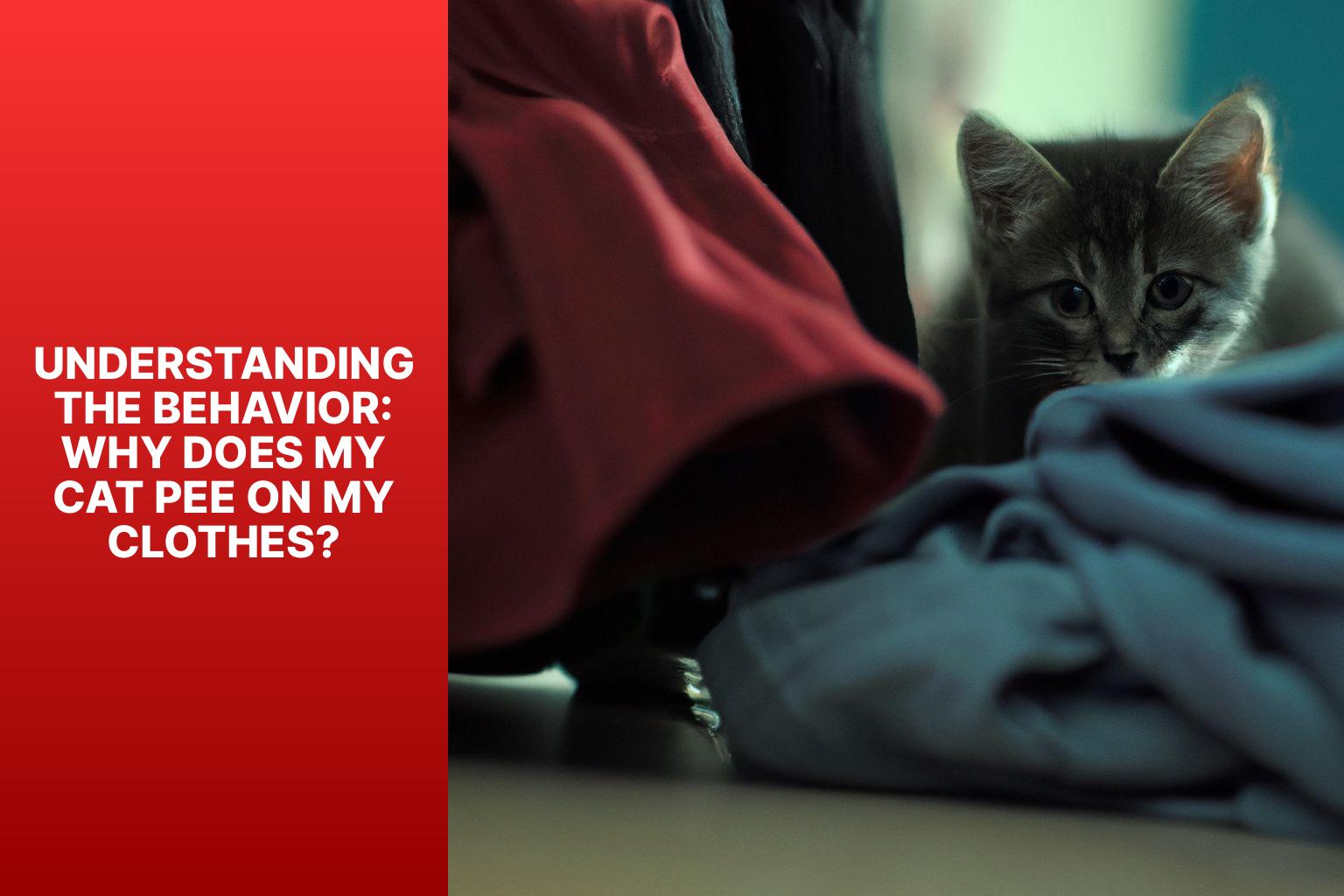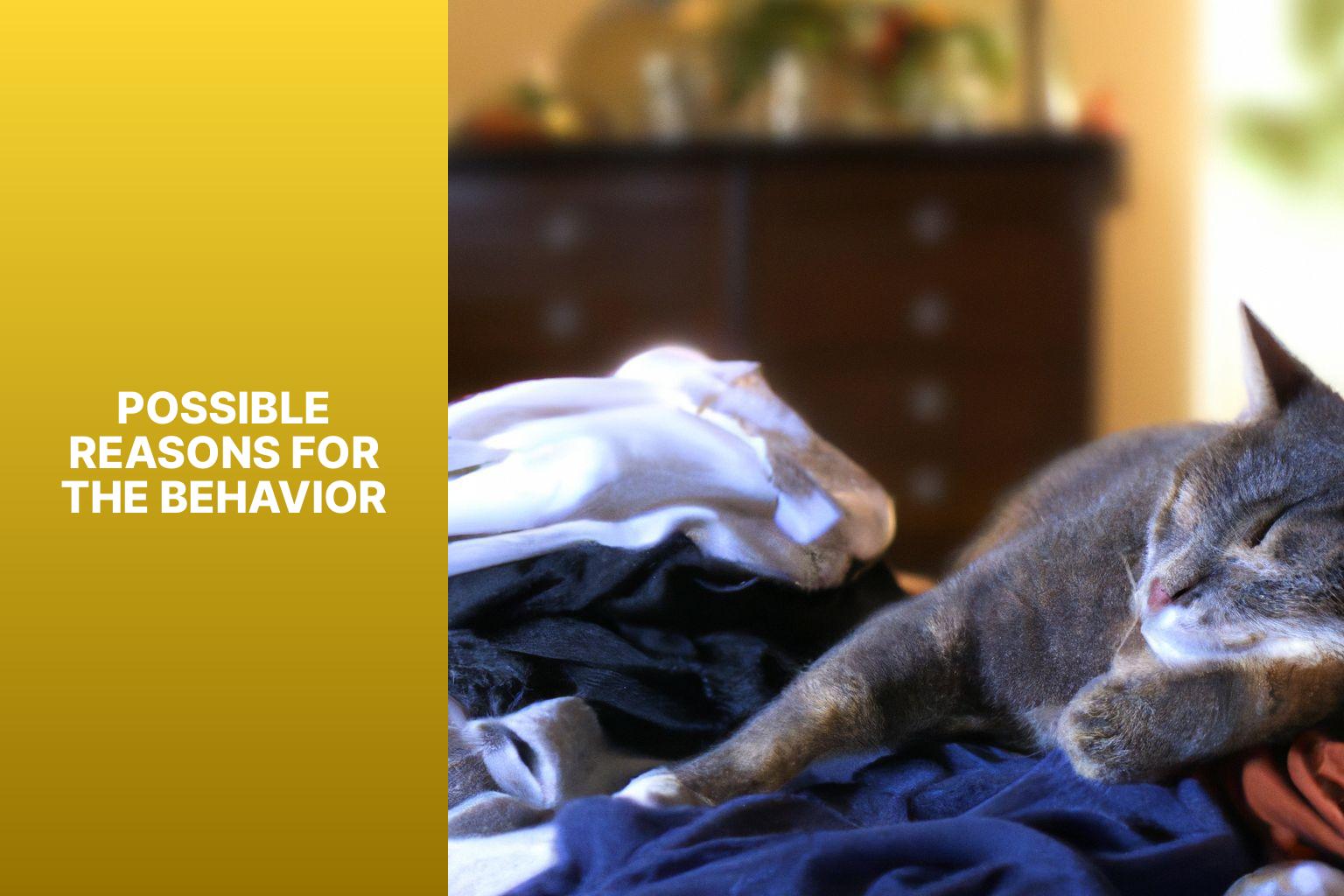Understanding the Behavior: Why Does My Cat Pee on My Clothes?
One frustrating and unpleasant behavior that cat owners may encounter is finding their cat peeing on their clothes. This article delves into the possible reasons behind this behavior and provides solutions to address it.
Possible Reasons for the Behavior:
1. Litter Box Issues: Cats are known for their cleanliness, and if the litter box is not up to their standards, they may seek alternative places to relieve themselves.
2. Marking Territory: Cats are territorial animals, and they may spray or urinate on clothes to mark their territory, especially if they feel threatened or insecure in their environment.
3. Stress or Anxiety: Cats can become stressed or anxious due to changes in their routine, introduction of new pets or people, or environmental factors. This can lead to inappropriate elimination.
4. Medical Conditions: Sometimes, underlying medical issues like urinary tract infections or bladder stones can cause cats to urinate outside the litter box.
Addressing Litter Box Issues:
To resolve litter box issues, ensure cleanliness by scooping the litter box daily and replacing the litter regularly. Place the litter box in a quiet and accessible location, away from noisy appliances or high-traffic areas. Experiment with different types of litter to find one that your cat prefers.
Addressing Marking Behavior:
If marking territory is the issue, consider neutering or spaying your cat to reduce their inclination to mark. Provide environmental enrichment, such as scratching posts and interactive toys, to redirect their marking behavior. Pheromone products can help reduce marking behavior.
Addressing Stress or Anxiety:
Create a safe and secure environment for your cat by providing hiding spots, perches, and vertical space. Establishing a consistent routine can help reduce anxiety. Engage your cat in play sessions and provide mental stimulation to alleviate stress.
When to Seek Veterinary Help:
If the behavior persists or is accompanied by other concerning symptoms, it is advisable to seek veterinary help. A veterinarian can diagnose and treat underlying medical conditions that may be causing the inappropriate elimination. In severe cases, collaborating with a veterinary behaviorist can provide specialized guidance for resolving the issue.
By understanding the reasons behind your cat’s behavior and implementing appropriate solutions, you can effectively address the issue of your cat peeing on your clothes and create a harmonious living environment for both you and your feline companion.
Key takeaway:
- Understanding the Behavior: Cats may pee on clothes due to litter box issues, marking territory, stress or anxiety, or medical conditions.
- Addressing Litter Box Issues: Keeping the litter box clean, placing it in the right location, and choosing the appropriate type of litter can help prevent cats from peeing on clothes.
- Addressing Marking Behavior: Neutering/spaying the cat, providing environmental enrichment, and using pheromone products can help alleviate marking behavior.
Understanding the Behavior: Why Does My Cat Pee on My Clothes?
Photo Credits: Www.Catcornerblog.Com by Richard Ramirez
Cats may pee on clothes for various reasons. Understanding their behavior, specifically why does my cat pee on my clothes, can help address the issue effectively. Possible reasons include medical conditions like urinary tract infections or bladder stones, territorial marking triggered by other animals or environmental changes, stress or anxiety caused by household changes or new pets, litter box issues such as cleanliness or placement, and behavioral problems like lack of litter box training or texture preferences. It is important to consult a veterinarian to rule out medical conditions. Maintaining a clean litter box, providing a stress-free environment, and offering behavioral enrichment can prevent cats from urinating on clothes.
Possible Reasons for the Behavior
Photo Credits: Www.Catcornerblog.Com by Lawrence Robinson
From litter box issues to marking territory, stress or anxiety, and even medical conditions, this section explores the possible reasons why your feline companion might be peeing on your clothes. Let’s dive into each sub-section and uncover the insights that reveal the underlying causes behind this peculiar behavior. So, if you’ve ever wondered what’s going on in your cat’s mind, hold on tight as we explore the possible explanations behind this mysterious phenomenon.
Litter Box Issues
Litter box issues can cause cats to pee on inappropriate surfaces. Addressing these issues is crucial for your cat’s proper bathroom habits.
1. Keep it clean: Cats prefer a clean litter box. Scoop daily and change litter regularly to maintain cleanliness.
2. Choose the right location: Proper placement is important. Put the litter box in a quiet and accessible area where your cat feels safe. Avoid loud appliances or high foot traffic.
3. Find the right litter: Cats may have preferences for certain types of litter. Experiment with different textures and scents to find what your cat likes.
4. Provide enough litter boxes: It’s recommended to have one box per cat, plus an extra. Some cats prefer separate boxes for peeing and pooping, so having multiple options can prevent accidents.
By addressing these litter box issues, you can prevent your cat from peeing on inappropriate surfaces. Remember, every cat is unique, so it may take some trial and error to find the best solution for your furry friend.
Did you know that some cats dislike covered litter boxes? They may feel trapped or claustrophobic. Using an open litter box could help resolve litter box issues.
Marking Territory
Marking territory is a common behavior in cats. Understanding the reasons behind this behavior can help address and manage it effectively.
– Cats mark their territory by spraying urine or rubbing against objects with scent glands. This signals to other cats that the area belongs to them.
– The act of marking territory is a natural instinct in cats, particularly for unneutered males. It serves to establish their dominance and communicate their presence to others.
– Cats may engage in marking territory as a response to the presence of other cats. This can manifest as a territorial dispute or as a way to establish boundaries in a multi-cat household.
– Marking territory can also be an indication of anxiety or stress. Changes in the cat’s environment, such as moving or introducing a new pet, can trigger this behavior.
– Certain medical conditions, such as urinary tract infections or bladder stones, can also contribute to marking behavior. It is crucial to visit a veterinarian to rule out any underlying health issues.
To effectively address marking territory behavior, it is important to create a cat-friendly environment, ensure proper litter box hygiene, and consider the option of neutering or spaying. Seeking guidance and support from a veterinarian or a veterinary behaviorist can also be beneficial in managing and modifying this behavior.
Stress or Anxiety
- Create a Safe and Secure Environment: Cats may experience stress or anxiety if they feel unsafe or threatened. Provide hiding spots, elevated climbing areas, and ensure there are no aggressive animals or loud noises that can cause stress.
- Establish a Consistent Routine: Cats thrive on routine and predictability. Stick to regular feeding, playtime, and litter box cleaning to minimize stress and anxiety.
- Provide Play and Mental Stimulation: Engage in regular play sessions with your cat to release energy and provide mental stimulation. Use interactive toys and puzzle feeders to keep them occupied and entertained.
When dealing with stress or anxiety, be patient and understanding. Cats may need time and comfort to overcome their anxieties. Consulting with a veterinarian or veterinary behaviorist can help develop a customized plan for your cat’s needs. Remember, each cat is unique, so what works for one may not work for another. With the right approach and support, you can help your cat feel calm and comfortable in their environment.
Medical Conditions
Medical conditions can cause cats to pee on clothes. Here are some conditions that could lead to this behavior:
- Urinary tract infection (UTI): UTIs can cause discomfort and increased urgency to urinate, leading to accidents.
- Bladder stones: Hard mineral deposits that cause pain during urination, leading to avoidance of the litter box.
- Bladder inflammation (cystitis): Inflammation of the bladder can cause pain and discomfort, resulting in urinating in inappropriate places.
- Kidney disease: Cats with kidney disease may have increased thirst and urination, leading to accidents if the litter box is not easily accessible.
- Diabetes: Increased urination is a common symptom of diabetes. Cats with uncontrolled diabetes may pee on clothes if the litter box is not conveniently located.
One cat owner noticed her cat, Luna, repeatedly urinating on freshly washed clothes. Concerned, she took Luna to the veterinarian, who discovered a urinary tract infection. After treatment, Luna stopped peeing on the clothes and resumed using the litter box faithfully.
Addressing Litter Box Issues
Dealing with a cat that pees on your clothes can be frustrating. In this section, we’ll dive into effective strategies for addressing litter box issues. We’ll explore the importance of cleanliness in the litter box area, proper placement of the litter box, and choosing the right type of litter. By implementing these tips, you can create a more pleasant environment for your feline friend and prevent any unwanted accidents. Let’s get started on finding solutions for a pee-free wardrobe!
Ensuring Cleanliness
Ensuring cleanliness is of utmost importance when it comes to addressing litter box issues and preventing your cat from urinating on your garments. It is crucial to clean the litter box on a daily basis. This involves promptly scooping out waste and clumps in order to maintain cleanliness, prevent the buildup of odors, and create a comfortable environment for your feline companion.
It is recommended to use unscented litter, as cats possess a sensitive sense of smell and may be deterred by strong scents. Opting for unscented litter provides a neutral and enticing option for your cat to use. It is important to regularly replace the litter. Over time, soiled litter loses its ability to effectively absorb odors. Therefore, it is advisable to completely replace the litter every one to two weeks in order to uphold cleanliness.
Another useful tip is to consider utilizing a litter mat. Placing a mat outside the litter box can capture any litter that your cat may track out, thereby reducing mess and ensuring the cleanliness of the surrounding area. If you have multiple cats, it is essential to provide multiple litter boxes. Each cat should have their own designated litter box to avoid overcrowding, minimize stress, and uphold cleanliness.
It is also vital to keep the litter box in a quiet and easily accessible location. Cats prefer privacy when using the litter box, so it is recommended to choose a location that is away from noise and high foot traffic to provide a peaceful environment. It is worth considering using a litter box with a lid. Some cats prefer the added privacy and security that a covered box provides. A covered box helps contain odors and prevents litter from scattering outside the box.
By implementing these cleanliness measures, you can effectively address litter box issues and ensure a hygienic environment for your beloved cat.
Proper Placement of the Litter Box
Proper placement of the litter box is crucial for ensuring your cat consistently uses it and avoids urinating on your clothing.
Choose a quiet and easily accessible location for the litter box. Cats prefer privacy, so position it away from noise and foot traffic.
If you have a large home or multiple floors, place litter boxes in various locations. This guarantees convenient access for your cat, regardless of where they are in the house.
Keep the litter box separate from food and water sources. Cats naturally avoid using the bathroom near their food and water, so this precaution helps prevent accidents.
Ensure the litter box is easily accessible for your cat, especially if they are older or have mobility issues. Use a litter box with low sides or a ramp if necessary.
Consider placing litter boxes on each level of your home, particularly in multi-story houses, to provide convenient options for your cat.
Following these steps for the proper placement of the litter box can effectively encourage your cat to consistently use it, reducing accidents on your clothing.
Choosing the Right Type of Litter
When choosing litter for your cat, consider the following factors:
1. Odor control: Look for litter designed specifically to control odor. Different litters use techniques like activated charcoal or baking soda to neutralize smells.
2. Clumping ability: Clumping litters make it easier to clean the litter box. They form solid clumps when liquid touches them, making scooping and disposal simpler.
3. Dust level: Some litters, especially clay-based ones, produce a lot of dust. This can cause respiratory problems for both you and your cat. Look for low-dust or dust-free options.
4. Texture: Cats have preferences for litter texture. Some prefer a finer, sand-like texture, while others prefer coarser litter. You may need to try different textures to find what your cat prefers.
5. Non-tracking: To minimize litter tracking in your house, choose a litter with larger granules that are less likely to stick to your cat’s paws.
Pro-tip: Start with small amounts of a new litter and observe your cat’s reaction. If your cat consistently avoids or shows discomfort with a certain litter, try a different one. Remember, each cat is unique, and finding the right litter may require some trial and error.
Addressing Marking Behavior
Marking behavior can be a frustrating challenge for cat owners. In this section, we’ll explore effective ways to address this issue. From the benefits of neutering/spaying to providing environmental enrichment and utilizing pheromone products, we’ll uncover the strategies that can help curb this behavior. No more worries about your favorite clothes being targeted. Let’s dive into the solutions for addressing marking behavior in our feline friends.
Neutering/Spaying
– Neutering/spaying can help prevent cats from urinating on clothes and marking their territory.
– Neutering/spaying eliminates the hormonal drive to mark territory by urinating.
– Neutering/spaying also reduces other undesirable behaviors associated with the mating instincts of cats.
Providing Environmental Enrichment
To address cats peeing on clothes, incorporating providing environmental enrichment is essential. Here are some natural ways to achieve this:
-
Offer interactive toys: Engage cats in playtime with toys that encourage physical activity and mental stimulation, thus providing environmental enrichment. This can divert their attention from inappropriate elimination behaviors.
-
Create vertical spaces: Install cat trees or shelves to provide vertical spaces in your home. Cats enjoy climbing and perching, allowing them to explore their surroundings and feel secure, which is a form of environmental enrichment.
-
Provide scratching posts: Offer appropriate outlets for cats’ natural scratching instinct. Scratching posts or boards can keep their claws healthy and prevent damage to furniture or clothes, contributing to environmental enrichment.
-
Offer hiding spots: Provide areas where cats can retreat and feel safe, such as covered beds, boxes, or rooms with comfortable hiding spaces. This kind of environment enrichment allows cats to have a sense of security.
-
Rotate toys and stimuli: Keep cats mentally engaged by regularly changing their toys and providing new stimuli. This prevents boredom and adds variety to their environment, which enhances environmental enrichment.
-
Window perches: Place perches near windows so cats can observe the outside world. Watching birds, squirrels, or other outdoor activities can stimulate their natural hunting instincts, providing environmental enrichment.
Remember, providing environmental enrichment effectively addresses cats’ physical and mental needs, thereby reducing the likelihood of inappropriate elimination on clothes.
Using Pheromone Products
- Pheromones are chemical substances animals use to communicate with others of the same species. Using pheromone products can help your cat feel more relaxed and secure in their environment.
- Pheromone products come in forms like sprays, diffusers, and collars. These products release synthetic versions of the pheromones cats naturally produce.
- To address your cat’s inappropriate peeing behavior with pheromones, follow the product manufacturer’s instructions.
- Pheromone products can reduce stress and anxiety in cats, common triggers for inappropriate urination. They create familiarity and comfort in the cat’s environment.
- Pheromone products are generally safe to use and do not have known negative side effects. If you notice any unusual reactions or behaviors in your cat after using pheromone products, consult your veterinarian.
Using pheromone products can be helpful in addressing your cat’s inappropriate peeing behavior. Remember to use them as part of a comprehensive approach that includes addressing other possible causes and providing appropriate litter box care. If your cat continues to exhibit inappropriate peeing behavior despite using pheromone products, seek veterinary assistance for further evaluation and guidance.
Addressing Stress or Anxiety
When it comes to understanding why our beloved cats have the tendency to pee on our clothes, addressing stress and anxiety plays a crucial role. In this section, we will explore effective ways to tackle this issue head-on. From creating a safe and secure environment to establishing a consistent routine, and providing adequate play and mental stimulation, we’ll dive into practical tips and strategies to help alleviate stress and anxiety in our feline friends. No more pesky surprises on our favorite outfits!
Creating a Safe and Secure Environment
Creating a safe and secure environment for your cat is essential to prevent them from urinating on your clothes. Here are some steps you can take to achieve this:
1. Provide a designated space: Ensure that your cat has a comfortable and private area where they can retreat when they feel stressed or anxious. This can be a separate room or a cozy corner equipped with their bed, toys, and scratching posts.
2. Eliminate stressors: Identify and remove anything that may cause stress for your cat. This includes loud noises, sudden changes in routine, or conflicts with other pets. Creating a calm and peaceful environment will help your cat feel secure.
3. Use pheromone products: Consider incorporating pheromone diffusers or sprays that mimic natural cat pheromones. These products can create a sense of familiarity and security for your cat, reducing anxiety-related behaviors such as inappropriate urination.
4. Provide hiding spots: Cats feel safer when they have places to hide. Ensure there are plenty of hiding spots available, such as cardboard boxes or cat condos, where your cat can feel secure and hidden from view if desired.
5. Keep the litter box clean: Cats are clean animals, so it is important to maintain a clean and accessible litter box. Regularly scoop the litter box and change the litter as necessary. Avoid placing the litter box near noisy appliances or in busy areas.
By establishing a safe and secure environment for your cat, you can help minimize stress and prevent them from soiling your clothing. Remember to consult with a veterinarian if the behavior persists, as it may indicate an underlying medical issue.
I had a cat named Whiskers who occasionally urinated on my clothes. After conducting research, I discovered that she was stressed due to stray cats outside our home. To create a safe and secure space for her, I installed window blinds to block the view and provided hiding spots and pheromone diffusers. These measures significantly reduced her stress, and she stopped urinating on my clothes. Establishing a safe space for your cat can greatly enhance their behavior and overall well-being.
Establishing Consistent Routine
Establishing a consistent routine is crucial when it comes to addressing your cat’s habit of peeing on your clothes. Here are some steps to consider in order to establish this routine:
1. Establish a feeding schedule: It is important to feed your cat at the same time every day. This promotes regular bathroom habits and helps create a sense of predictability.
2. Keep the litter box clean: It is essential to scoop waste daily and change the litter as needed. This maintains cleanliness and hygiene, ensuring that the litter box remains attractive and accessible to your cat.
3. Choose an appropriate location for the litter box: Select a quiet and private area that is easily accessible to your cat. Avoid placing it near noisy appliances or in busy areas to reduce stress and distractions.
4. Engage in regular play and exercise: Make sure to interact with your cat through play and provide stimulating toys and activities. Regular playtime helps reduce stress and anxiety, which can contribute to inappropriate urination.
5. Maintain a consistent environment: Try to avoid making major changes to your cat’s surroundings, such as moving furniture or introducing new pets. These changes can disrupt their routine and cause stress.
Remember, it takes time and patience to establish a consistent routine. Observe your cat’s behavior and make any necessary adjustments. If needed, consult with a veterinary behaviorist who can offer expert guidance on effectively addressing the issue.
Provide Adequate Play and Mental Stimulation
To adequately provide play and mental stimulation for your cat, consider following these steps:
– Employ interactive toys that effectively stimulate your cat’s hunting instincts, such as feather wands or treat-dispensing puzzles.
– Regularly rotate your cat’s toys to prevent boredom and occasionally introduce new toys.
– Allocate dedicated play sessions with your cat, aiming for at least 10-15 minutes twice a day. Utilize toys that encourage running, jumping, and chasing.
– Supply scratching posts or boards in different areas of your home to allow your cat to exercise their natural scratching behavior.
– Establish vertical spaces, like cat trees or shelves, where your cat can climb, perch, and observe their surroundings.
– Permit your cat to watch outdoor wildlife from a window perch or windowsill, effectively stimulating their curiosity.
– Conceal treats or toys around your home to encourage your cat to find them, thereby keeping their mind active.
– Introduce various sensory experiences, such as different textures, sounds, and scents, to consistently keep your cat mentally stimulated.
– Use puzzle feeders or hide food in different locations to simulate hunting and foraging behaviors, thereby keeping your cat engaged during mealtimes.
When to Seek Veterinary Help
Is your cat having an unusual habit of peeing on your clothes? Don’t worry, we’ve got you covered. In this section, we’ll discuss when it’s time to seek veterinary help for this problem. We’ll explore the importance of diagnosing and treating any underlying medical conditions that could be causing this behavior. We’ll delve into the benefits of working with a veterinary behaviorist to solve this issue. So, let’s dive in and find ways to help your furry friend and keep your clothes pee-free!
Diagnosing and Treating Medical Conditions
Diagnosing and treating medical conditions is vital when it comes to addressing the behavior of a cat peeing on clothes.
To effectively diagnose medical conditions, a veterinarian will perform a physical examination and may request additional tests such as blood work, urine analysis, and imaging.
Inappropriate urination can be caused by a variety of common medical conditions, including urinary tract infections, bladder stones, and feline lower urinary tract disease.
The treatment options will depend on the specific medical condition that is identified. Antibiotics may be prescribed for urinary tract infections, while bladder stones may require surgical removal.
In addition to medication, pain management and inflammation control can be achieved through the prescribed medications to promote healing and relieve discomfort.
It is crucial to carefully follow the veterinarian’s advice regarding the administration, dosage, and duration of the medication in order to effectively address the cat’s health.
Regular follow-up appointments may be necessary to monitor the cat’s progress and make any necessary adjustments to the treatment plan.
By understanding and addressing the underlying medical conditions, cat owners can play a crucial role in resolving the behavior of their cat peeing on clothes and promoting the overall well-being of their feline companions.
Working with a Veterinary Behaviorist
Working with a Veterinary Behaviorist can help identify and address the underlying causes of your cat peeing on your clothes. Here are key steps a Veterinary Behaviorist may take:
1. Evaluate the cat’s medical history and conduct a thorough physical examination to rule out potential underlying medical conditions.
2. Assess the cat’s behavior and environment to determine possible triggers or stressors contributing to inappropriate elimination.
3. Create a customized behavior modification plan, including techniques like litter box training, environmental enrichment, and desensitization exercises.
4. Recommend modifications to the home environment, such as creating designated elimination areas and providing additional litter boxes, to offer a safe and secure space for the cat.
5. Prescribe medications, if needed, to alleviate anxiety or stress causing the inappropriate elimination behavior.
6. Monitor progress closely and adjust the behavior modification plan as necessary.
Working closely with a Veterinary Behaviorist can significantly enhance the chances of resolving the problem. They have the expertise and experience to analyze the situation comprehensively and devise an effective intervention plan tailored to your cat’s needs.
Some Facts About Why Cats Pee on Clothes:
- ✅ Cats may pee on clothes due to medical, behavioral, or litter box causes. (Source: PetPedia)
- ✅ Feline Lower Urinary Tract Disease (FLUTD) is a common medical cause for cats peeing outside the litter box. (Source: Excited Cats)
- ✅ Cats may urinate in places other than their litter tray due to stress, fear, and bullying. (Source: Excited Cats)
- ✅ Some cats may avoid using a dirty litter tray, even if it contains their own waste. (Source: Excited Cats)
- ✅ Arthritis in older cats can make it difficult for them to use the litter tray, leading to urination outside of it. (Source: Excited Cats)




